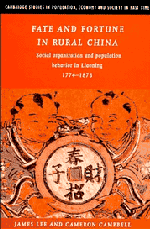Book contents
- Frontmatter
- Contents
- List of figures
- List of maps
- List of tables
- Acknowledgements
- PART 1 DAOYI VILLAGE
- PART 2 THE LIAONING DEMOGRAPHIC SYSTEM
- PART 3 HOUSEHOLD ORGANIZATION AND POPULATION BEHAVIOR
- PART 4 BANNER ORGANIZATION AND POPULATION BEHAVIOR
- EPILOGUE: PROSPECTS, IMPLICATIONS, AND COMPARISONS
- Appendices
- A Sources and methods for the population and family history of rural Liaoning
- B Statistical techniques
- C Household division contract of Lang Zhongqing and Lang Wenlin
- Glossary
- References
- Index
- Cambridge Studies in Population, Economy and Society in Past Time
A - Sources and methods for the population and family history of rural Liaoning
Published online by Cambridge University Press: 20 October 2009
- Frontmatter
- Contents
- List of figures
- List of maps
- List of tables
- Acknowledgements
- PART 1 DAOYI VILLAGE
- PART 2 THE LIAONING DEMOGRAPHIC SYSTEM
- PART 3 HOUSEHOLD ORGANIZATION AND POPULATION BEHAVIOR
- PART 4 BANNER ORGANIZATION AND POPULATION BEHAVIOR
- EPILOGUE: PROSPECTS, IMPLICATIONS, AND COMPARISONS
- Appendices
- A Sources and methods for the population and family history of rural Liaoning
- B Statistical techniques
- C Household division contract of Lang Zhongqing and Lang Wenlin
- Glossary
- References
- Index
- Cambridge Studies in Population, Economy and Society in Past Time
Summary
Background
For almost half a century, two advances in population and family history have been central to the rapid expansion of quantitative, social scientific history. First in the late 1950s, demographers developed a body of analytical techniques known as family reconstitution to calculate demographic rates from records of weddings, baptisms, and burials (Gautier and Henry 1958). Then in the late 1960s, a group of historians and anthropologists proposed and propagated a series of analytical classifications of household structure to measure changes in household complexity (Hammel and Laslett 1974; Laslett and Wall 1972). These two sets of techniques were among the first quantitative methods of social scientific analysis that were easily accessible to nearly all historians. Together they inspired many historical studies of fertility and mortality, marriage and migration, household structure and household formation, individual and domestic cycle. The results have produced a new set of objective measures of life in the past. At the same time, they have provided generalizable standards with which to compare the historical experiences of societies in different parts of the world.
Such studies have greatly expanded our appreciation of history from below. On the one hand, population history has not only defined the patterns of demographic behavior among the common people, but has also redefined our understanding of many social customs and economic conditions. On the other hand, family history not only has shown what types of households and household formation were common in the past, but has also shed new light on the organization of production, the transmission of property, and the rise of familial affect. European historians, in particular, have linked such changes to the transition from feudalism to capitalism.
- Type
- Chapter
- Information
- Fate and Fortune in Rural ChinaSocial Organization and Population Behavior in Liaoning 1774–1873, pp. 223 - 237Publisher: Cambridge University PressPrint publication year: 1997



